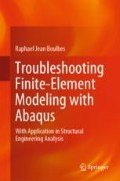Abstract
Within this chapter, users will find a general overview of Abaqus solver options, convergence issues, features definitions and usage plus a description of physics the solver can handle. It starts with the vocabulary and translation of error and warning messages in engineering terms; to fix troubleshooting errors, first users need to understand them. Classic preliminary control milestones with tips and tricks are also given to make debugging more efficient. Differences between both Abaqus solvers standard and explicit have been explained with the procedures and option settings, to stop struggling with time increment. Additional solver options and coupled field analyses including CFD are also clearly detailed to get stability and convergence in FEA model. After reading this chapter, users will have gained complementary knowledge regarding troubleshooting prevention.
Access this chapter
Tax calculation will be finalised at checkout
Purchases are for personal use only
Notes
- 1.
Please note that the factor “fifty” mentioned in the warning message cannot be modified.
- 2.
See the Sect. 8.9 inside this book to get further explanations.
- 3.
See the Sect. 8.10 inside this book to get further explanations.
- 4.
See the Sect. 8.11 inside this book to get further explanations.
- 5.
More details about the time integration scheme are presented inside Abaqus documentation Theory Manual, in Sect. 2.2.1 Nonlinear solution methods in Abaqus/Standard and in Sect. 2.4 Nonlinear dynamics
- 6.
An example of stability and accuracy of the trapezoidal rule is given in Appendix A.3.
- 7.
Users will be able to find an example of a double cantilever elastic beam under point load in Abaqus Benchmark Problem 1.3.2 in the Abaqus Benchmarks Manual. After comparing the Abaqus/Standard and Abaqus/Explicit results, the results obtained with the default incrementation schemes show excellent agreement. Using a tighter half-increment residual tolerance for the implicit analysis further improves the agreement.
- 8.
Using the *STATIC, RIKS, DIRECT command gives a user direct control over the increment size; in this case, the incremental arc length \(\varDelta l\), is kept constant. This method is not recommended for a Riks analysis since it prevents Abaqus standard from reducing the arc length when a severe nonlinearity is encountered.
- 9.
This equation can be linearized in a \(log_{10}\) base such as \(Log(N) = Log(a) - mLog(S)\), with the couple of parameters \(\left( Log(a);m\right) \) depending of the construction details of the crack, the loading conditions and the number of cycles.
- 10.
A direct cyclic analysis can be used to directly calculate the cyclic response of a structure subjected to a number of repetitive loading cycles. The direct cyclic algorithm uses a modified Newton method in conjunction with a Fourier representation of the solution and the residual vector to directly obtain the stabilized cyclic response.
- 11.
An example is given inside the Abaqus Benchmarks Guide Sect. 1.19.2 Crack propagation in a plate with a hole simulated using XFEM.
- 12.
See the Automatic stabilization of unstable problems inside Abaqus Analysis User’s Manual in Sect. 7.1.1 Solving nonlinear problems.
- 13.
Set TYPE \(=\) FSI to set the parameters that will be used in deforming-mesh problems involving moving boundaries or deforming geometries in Abaqus CFD as well as an Abaqus CFD to Abaqus standard or to Abaqus explicit co-simulation. This parameter setting can be used only in Abaqus CFD analyses.
- 14.
See in documentation Abaqus User Subroutines Reference Guide.
References
Press WH, Vetterling WT, Teukolsky SA (2006) Numerical recipes in Fortran 77, the art of scientific computing, 2nd edn. Cambridge University Press, Cambridge, p. 827
Hilber HM, Hughes TJR, Taylor RL (1977) Improved numerical dissipation for time integration algorithms in structural dynamics. Earthquake Eng Struct Dyn 5:283–292
Riks E (1979) An incremental approach to the solution of snapping and buckling problems. Int J Solids Struct 15:529–551
Author information
Authors and Affiliations
Rights and permissions
Copyright information
© 2020 Springer Nature Switzerland AG
About this chapter
Cite this chapter
Boulbes, R.J. (2020). General Prerequisites. In: Troubleshooting Finite-Element Modeling with Abaqus. Springer, Cham. https://doi.org/10.1007/978-3-030-26740-7_4
Download citation
DOI: https://doi.org/10.1007/978-3-030-26740-7_4
Published:
Publisher Name: Springer, Cham
Print ISBN: 978-3-030-26739-1
Online ISBN: 978-3-030-26740-7
eBook Packages: EngineeringEngineering (R0)

